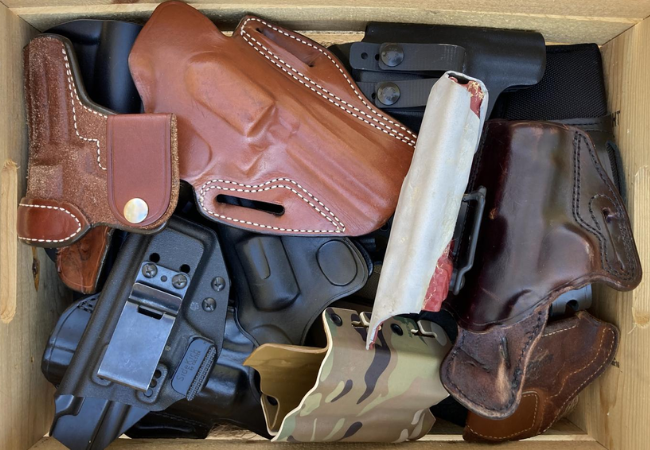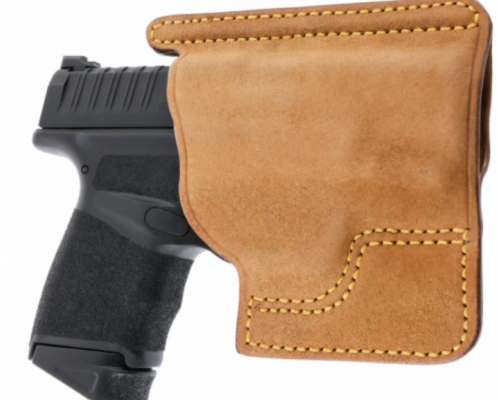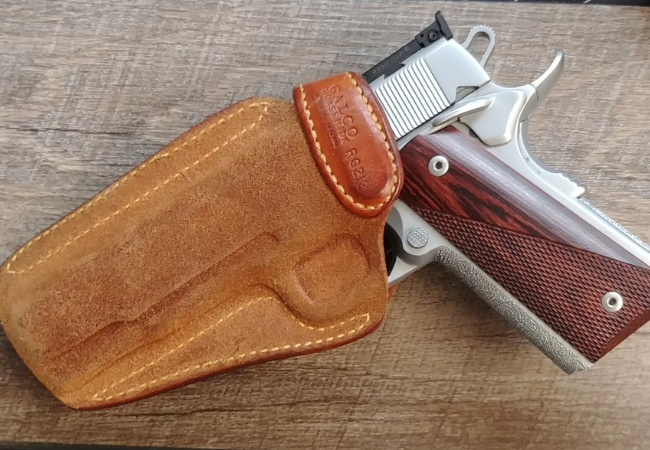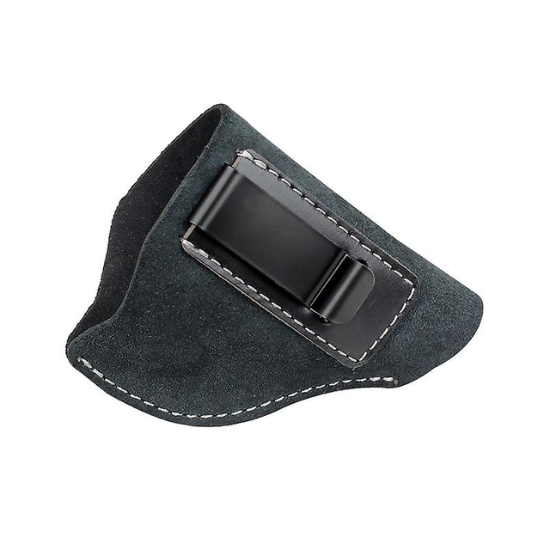In the world of personal defense and law enforcement, the right equipment can mean the difference between success and failure.
Among the essential elements that contribute to the performance and comfort of a weapon holder, the choice of holster material stands out.

Two prominent options, cowhide and horsehide, have been the subject of intense debate among firearm enthusiasts and professionals alike.
The characteristics of these leathers, from weight and flexibility to how they interact with oil, play a significant role in their suitability for holstering handguns and pistols.
Other alternatives, such as nylon and plastic, have also emerged as competitive materials, but the classic appeal of leather continues to hold sway.
In the quest to find the perfect balance between aesthetics and function, many find themselves torn between cowhide’s accessibility and horsehide’s durability.
This article will explore the nuances of these materials, contrasting them with other options and examining how they perform in different environments, including their use with waistband and crossbreed holsters.
Whether for a professional law enforcement officer or a dedicated firearm hobbyist, the information in this article will guide the selection of the perfect holster to suit one’s specific needs.
Cowhide Holster
Cowhide, one of the most widely used animal skins, has become a staple in the world of firearms, especially in the creation of handgun holsters.
Its availability, affordability, and adaptability make it a go-to choice for many law enforcement officers and firearm enthusiasts.

Unlike horsehide, cowhide often features a looser grain, giving it unique characteristics that can be both an advantage and a drawback.
When it comes to flexibility and ease of maintenance, cowhide often comes to the forefront.
Its ability to resist wrinkles, coupled with a natural affinity for oil, makes it durable and easy to care for.
Cowhide can be tailored into various products, from jackets and shirts to robust holsters designed to carry different calibers of weapons, from small handguns of revolver to the powerful .50 BMG ammo.
While water resistance may not be as strong as horsehide, proper treatment and care can enhance this aspect of cowhide, making it suitable for various environments.
The way cowhide absorbs dye allows for a rich and varied color palette, lending itself to aesthetic customization that appeals to a broad range of users.
The connection between cowhide and other aspects of daily life goes beyond mere function.
From the rhetoric used in marketing these products to the way they interact with everyday items like mobile phones, the influence of cowhide can be seen in various domains.
Its versatility even extends into the scientific realm, with connections to cell biology through the study of animal tissues.
In terms of modern synthetic alternatives, materials like Acrylonitrile Butadiene Styrene (ABS) have made their mark, but they often fall short in replicating the feel and natural appeal of cowhide.
The tactile sensation, the weight, and even the very essence of cowhide make it a material that continues to be highly regarded in the world of firearms.
Pros of Cowhide Holster:
- Cowhide is generally more affordable than horsehide.
- It offers good flexibility, especially when well-maintained.
- The looser grain provides unique texture and appearance.
- Cowhide is widely available in various colors and styles.
- It can be conditioned to resist water and environmental damage.
- With proper care, cowhide can last for a long time, offering good durability.
Cons of Cowhide Holster:
- It might not be as resistant to water as horsehide without proper treatment.
- Cowhide may absorb oils and stains more readily.
- The looser grain may lead to more visible wear and wrinkling over time.
- Depending on the quality, cowhide might not hold its shape as well as horsehide.
- Some may prefer the feel and appearance of other types of leather or materials.
Horsehide Holster
Horsehide, renowned for its resilience and tight grain structure, has been a time-honored choice in the world of handgun holsters.
Law enforcement officers and gun enthusiasts frequently opt for horsehide over other animal hides, including goat, due to its specific characteristics.

One of the standout features of horsehide is its resistance to water.
Unlike many other types of leather, horsehide doesn’t readily absorb moisture, making it an excellent choice for those who may find themselves in damp or humid environments.
This water resistance also extends to its ability to ward off wrinkles, retaining its shape and appearance over time. Moreover, horsehide’s interaction with dye is something to marvel at.
The way it accepts color allows for vibrant and rich shades, enhancing the visual appeal of jackets, shirts, and, of course, handgun holsters.
This aesthetic aspect, coupled with its functional benefits, contributes to its continued popularity.
Horsehide’s adaptability doesn’t end with its appearance.
It’s capable of accommodating various calibers of weapons, from smaller handguns to the powerful .50 BMG.
Its strength and durability ensure that it provides a secure and reliable housing for these firearms.
In a world where synthetic materials like Acrylonitrile Butadiene Styrene (ABS) are becoming more prevalent, horsehide still holds its ground.
The natural feel, weight, and appearance of horsehide are difficult to mimic with synthetic alternatives.
Its tactile qualities continue to make it a preferred choice for many.
Beyond its practical applications, horsehide also holds a unique position in the broader context of animals and even cell biology.
Its structure and composition have made it a subject of study and appreciation in various scientific and cultural domains.
Furthermore, the rhetoric surrounding horsehide is often filled with reverence and respect.
It’s not just a material but a symbol of tradition, quality, and craftsmanship.
Its use extends beyond holsters to other personal items, including mobile phone cases, reflecting its versatility and broad appeal.
In conclusion, the overview of horsehide as a material for handgun holsters reveals a multifaceted entity.
Its physical properties, aesthetic qualities, cultural significance, and connections to broader themes make it a remarkable choice.
Whether for law enforcement officers in the line of duty or firearm enthusiasts looking for the perfect blend of form and function, horsehide continues to stand as a testament to the enduring appeal of natural materials in a world increasingly dominated by synthetics.
It’s more than just a material; it’s a legacy that continues to resonate in various aspects of life, from fashion to personal defense.
Pros of Horsehide Holster:
- Durability is one of horsehide’s strengths.
- It has a resistance to water, making it suitable for various environments.
- Horsehide’s aesthetic appeal is enhanced by how it accepts dye.
- It accommodates various calibers, from small handguns to the .50 BMG.
- Horsehide retains its shape well, resisting wrinkles over time.
- Traditional feel and appearance are hard to replicate with synthetic alternatives.
Cons of Horsehide Holster:
- Horsehide can be a bit more expensive than other types of leather, like cowhide.
- It might feel stiffer, particularly when new, which can affect comfort.
- Horsehide requires proper care and maintenance to retain its appearance and function.
- Some may find the texture or appearance not to their liking compared to other materials.
- Availability may be more limited, especially in specific colors or textures.
| Characteristic | Horsehide | Cowhide |
|---|---|---|
| Durability and Resistance | Highly durable, water-resistant | Durable, may require waterproofing |
| Flexibility and Comfort | Stiffer, may be less comfortable initially | More flexible, conforms to body |
| Aesthetic Appeal | Rich appearance, traditional allure | Unique textures, various colors and styles |
| Availability and Price | More expensive, less available | More affordable, widely available |
| Compatibility | Suitable for heavy firearms, less customization | Suitable for various firearms, more customization |
Characteristics of Horsehide and Cowhide Holsters
When it comes to choosing a holster material, two popular choices emerge: horsehide and cowhide.
Both these leather types have their unique features that cater to different needs and preferences.
This section explores their characteristics, examining how they stack up in terms of durability, aesthetics, and functionality.

Durability and Resistance
Horsehide is often prized for its durability and resistance to moisture. Compared to cowhide, it is less likely to absorb water, making it an excellent option for environments where moisture is a concern.
On the other hand, cowhide, while durable, may require additional waterproofing treatment to achieve similar resistance.
The choice between these two can often depend on the specific needs of the gun owner, the environment in which the holster will be used, and personal preferences related to the feel and appearance of the leather.
Flexibility and Comfort
Cowhide generally offers more flexibility and can be more comfortable against the body, especially when worn at the waistband. It tends to conform more easily to the body’s contours, providing a snug fit for the handgun.
Horsehide, on the other hand, may feel stiffer, particularly when new. While it might offer a more secure fit for heavier firearms like revolvers or Glock pistols, some users may find it less comfortable, especially when worn for extended periods. The choice between flexibility and rigidity could affect the decision between cowhide and horsehide.
Aesthetic Appeal
The way these two types of leather accept dye can influence their aesthetic appeal. Horsehide often offers a rich and distinct appearance, adding to its traditional allure.
Cowhide, with its looser grain, provides unique texture options and is available in various colors and styles, such as nubuck or suede.
The aesthetic preferences can vary widely among gun owners, and the decision between cowhide and horsehide may be influenced by individual tastes and the desired appearance of the holster, jacket, or other clothing.
Availability
Horsehide tends to be more expensive and might not be as readily available as cowhide. This is due to the specific processing required for horsehide and its relatively lower production compared to cowhide.
Those looking for a more budget-friendly option might lean towards cowhide, which is commonly found in various forms like Napa leather, suede, and shell cordovan.
The cost and availability factor might play a significant role in choosing between these two leather types, especially for those considering bulk purchases or specific customizations.
Compatibility with Firearms and Accessories
Both cowhide and horsehide are compatible with a wide range of firearms, from small handguns to AR-15 style rifles.

They can also be tailored to accommodate various accessories such as trigger guards, police duty belts, and more.
Cowhide might offer more flexibility in terms of customization, while horsehide’s rigidity can provide additional security for heavier weapons.
Whether used by law enforcement officers or gun ownership enthusiasts, the compatibility with different firearms and the potential for customization might influence the choice between cowhide and horsehide.
Conclusion
Choosing between horsehide and cowhide for a holster involves several factors like durability, comfort, aesthetics, affordability, and compatibility with firearms and accessories.
Each material has its unique advantages and drawbacks, and the selection may hinge on individual needs and intended holster usage.
With this understanding, one can make a well-informed decision that best meets their needs, whether for professional law enforcement, personal gun ownership, or other leather products.
Make sure to explore other holster options, such as the differences between M3 vs M7 Shoulder Holster and Vertical Shoulder Holster vs Horizontal, to find the perfect fit for your firearm.

